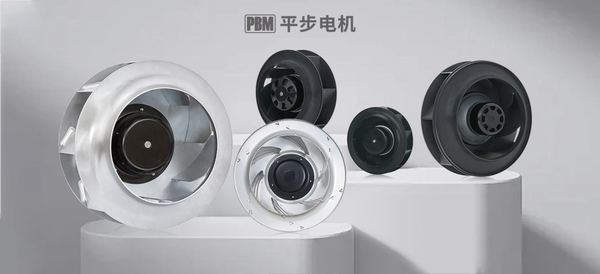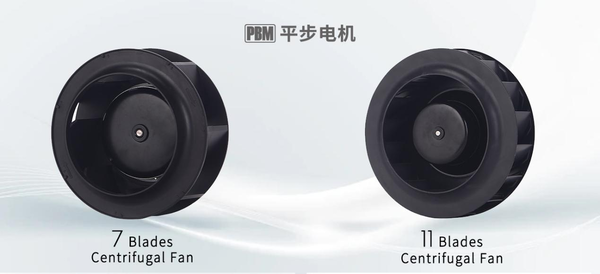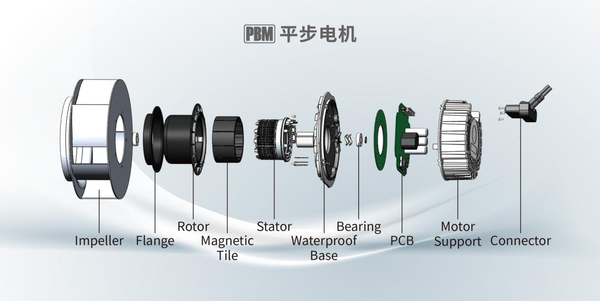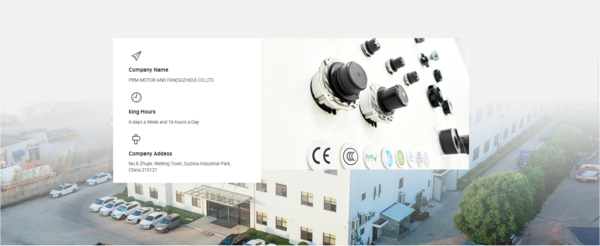All Rights Reserved Privacy Policy Site Map
FOCUS ON EC FAN ONLY
FOCUS ON EC FAN ONLY
The key factor affecting fan noise under normal working conditions is the shape design of the impeller. The impeller obtains energy from the air through rotation, therefore, in the design process, it is necessary to comprehensively consider factors such as blade material, quantity, shape, angle, bending degree, and thickness. At the same time, the clearance and sealing between the impeller and the casing should also be taken into consideration. To obtain the optimal impeller parameters, improve fan efficiency and performance, designers need to rely on theoretical analysis and precise calculations of fluid mechanics. A carefully designed impeller can effectively reduce the noise generated by rotating the wind turbine, providing users with a more peaceful operating environment.
In fluid design, the impeller is an important component, and the selection of its material has a significant impact on the performance and noise level of the equipment. In recent years, plastic impellers have gradually received attention due to their unique advantages.
Firstly, we need to understand the fundamental differences in physical properties between plastics and metals. Plastics have good flexibility and plasticity, while metals exhibit obvious rigidity and resistance to bending. This characteristic determines their different performance in fluid design.
Plastic impellers, due to their plasticity, can be finely designed and manufactured based on the characteristics of the fluid. This allows the plastic impeller to better adapt to fluid changes during rotation, reduce friction between the fluid and the impeller, simulate fluid motion characteristics more accurately, and thus reduce noise. In contrast, due to the rigidity of its material, metal impellers rely more on their straight up and straight down structure for rotation, which leads to greater friction between the fluid and the impeller and may result in higher noise levels.
It is worth noting that although plastic impellers have significant advantages in reducing noise, their durability and strength need to be taken into consideration. In order to improve the service life of plastics, PBM impellers are made of PA6+GF material. The addition of glass fiber can increase the rigidity of the material, and its mechanical properties such as tensile strength, bending strength, and heat resistance are significantly improved.

In summary, the application of plastic impellers in fluid design has significant advantages in reducing noise. This is mainly due to its good plasticity and machinability, which enables the impeller to better adapt to fluid changes and reduce friction. However, in practical applications, we also need to consider various factors comprehensively, such as workload, environmental conditions, etc., to choose the most suitable impeller material and design. With the advancement of technology and the development of materials science, we have reason to believe that plastic impellers will be applied in more fields, bringing more convenience and comfort to our lives and work.
This is a complex problem that requires comprehensive consideration of multiple factors. Generally speaking, an increase in the number of blades may cause more turbulent air flow, leading to increased noise. This is because more blades will interact more with the air, causing more turbulence and vibration, thereby generating noise. This viewpoint has some theoretical validity.

However, in actual testing, the PBM centrifugal fan model with 11 blades and 7 blades performed similarly in terms of air volume, indicating that the number of blades has an almost negligible impact on noise. In fact, multiple factors such as the design, manufacturing process, and application scenarios of fans have a crucial impact on noise levels. For example, the speed of the fan, the design of the volute, the balance of the impeller, and the lubrication of the bearings can all have an impact on noise.
In addition, having more blades can provide greater wind pressure, which means the wind can blow further. In certain application scenarios, such as duct fans, this feature may be more important. In the pipeline system, the wind pressure and air volume of the fan need to reach a certain balance to ensure the stable operation of the system. Therefore, when choosing a centrifugal fan, it is necessary to consider the specific application requirements comprehensively.
Analyzing the abnormal noise generated by a fan when it malfunctions is a crucial task. In the analysis process, we need to use rigorous and meticulous methods to identify whether it is mechanical noise or electronic noise, as these two types of noise have different causes and solutions.

Mechanical noise is usually caused by the vibration of mechanical components. These vibrations may be due to frictional, impact, or non-equilibrium forces between components during the operation of mechanical equipment. For example, impeller problems may cause vibration and imbalance during rotation, resulting in strong mechanical noise; The stator problem may affect the stability and balance of the fan, resulting in noise; Magnetic tile problems may cause fluctuations and instability in the magnetic field, resulting in noise; Bearing problems may cause wear and irregular movement of the bearings, resulting in noise; The balance problem of the fan may cause vibration and imbalance of the fan, resulting in noise; The problem with the snap ring may cause the fan to jam and move irregularly, resulting in noise; Transportation issues may cause the fan to experience bumps and impacts, resulting in noise.
Electronic noise is usually an abnormal noise that only occurs when powered on, but it does not occur when powered off. The causes of such noise may include air gap issues between the rotor and stator, magnetic issues with magnetic pads, magnetic field issues (such as oblique magnetization angle), and software issues. The existence of these issues may affect the normal operation of electronic components and generate abnormal electronic noise. Reasons for abnormal electronic noise:
Air gap between rotor and stator. The air gap is the space between the rotor and stator in a motor, which is crucial for the normal operation of the motor. If the air gap is too large or too small, it can cause friction and vibration between the rotor and stator, resulting in abnormal electronic noise. In addition, uneven air gaps can also cause the same effect. To solve this problem, it is necessary to carefully adjust the size and uniformity of the air gap to ensure the correct fit between the rotor and stator.
Magnetic tile magnetism.If the magnetism of the magnetic tile is insufficient or if there are cracks, detachment, and other phenomena on the magnetic tile, it will lead to a decrease in motor performance and generate abnormal electronic noise. To solve this problem, it is necessary to regularly inspect and replace the magnetic tiles, and ensure that the quality and magnetism of the tiles meet the requirements.
Magnetic field issues.If the magnetic field of the motor is uneven or the magnetization angle is incorrect, it can cause friction and vibration between the rotor and stator, resulting in abnormal electronic noise. To solve this problem, it is necessary to carefully adjust the size of the magnetic field and the magnetization angle to ensure the normal operation of the motor.
Software issues.In some motor control systems, if the algorithm or parameter settings of the software are incorrect, it may lead to unstable operation of the motor and generate abnormal electronic noise. To solve this problem, it is necessary to carefully check and adjust the algorithm and parameter settings of the software to ensure the normal operation of the motor.
Careful analysis and identification of abnormal noise are crucial for determining the cause of the fault and taking appropriate repair measures during troubleshooting. This requires us not only to understand various possible causes of faults, but also to use professional techniques and tools for accurate diagnosis and repair. By deeply analyzing the causes and characteristics of mechanical and electronic noise, we can more effectively solve the problem of fan failures, ensuring the normal operation and stable performance of the equipment.
PBM products can provide fast delivery. In today's fast-paced market environment, time is money. PBM products can quickly meet customer needs, and professional engineers provide technical services, greatly reducing the time from order to delivery. Not only can it save valuable time for customers, but it can also win market opportunities for them.
In addition to fast delivery, PBM products also offer customized services. Each customer's needs are unique, and the flexibility of PBM products allows them to be customized according to their specific needs. Whether it's product color, size, function, or packaging, PBM can meet the personalized requirements of customers, and the added value of this service is immeasurable.
In the future, with the continuous changes in the market and technological innovation, PBM stepper motors will uphold the concept of customer first, continuously improve product and service quality to meet the growing needs of customers. We deeply understand that only by truly understanding the needs of our customers can we provide them with the most satisfactory products and services. Therefore, we are not only committed to providing high-quality fan products, but also committed to becoming your trusted partner, providing you with comprehensive solutions and services.

If you have any questions about the fan, please feel free to contact us at any time. We will reply to your email or phone call as soon as possible and provide you with a satisfactory answer. We are always dedicated to serving you, ensuring that you have no worries during the use of the fan.
Thank you again for your attention and support. Looking forward to working with you!
By continuing to use the site you agree to our privacy policy Terms and Conditions.